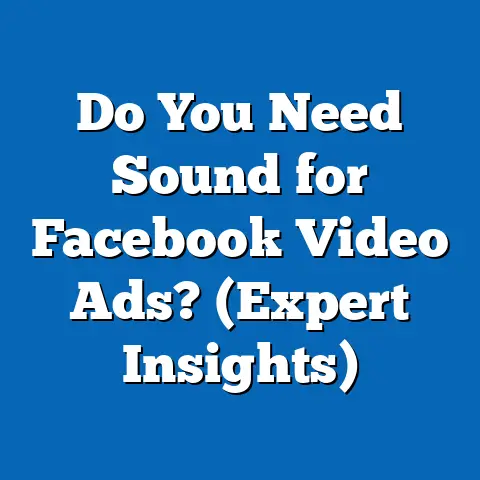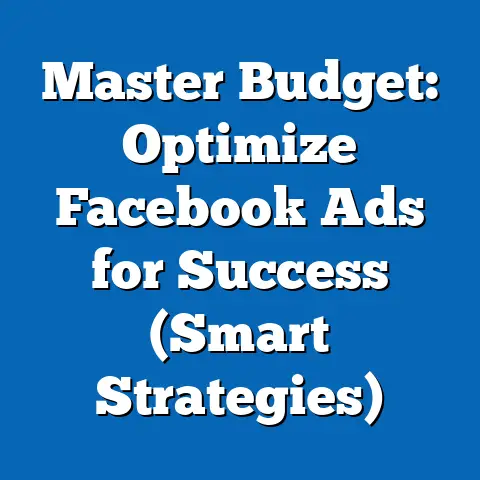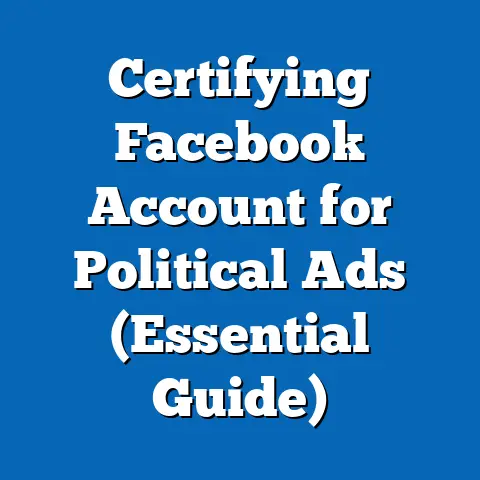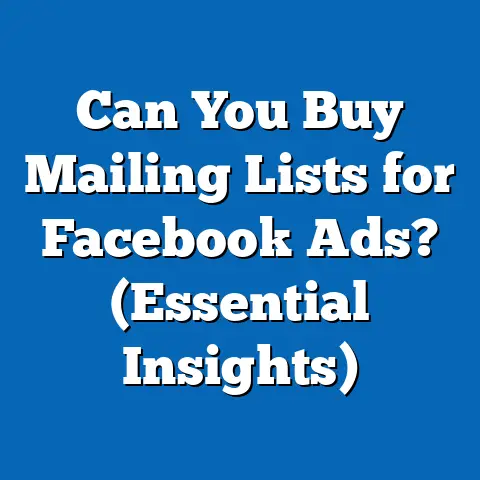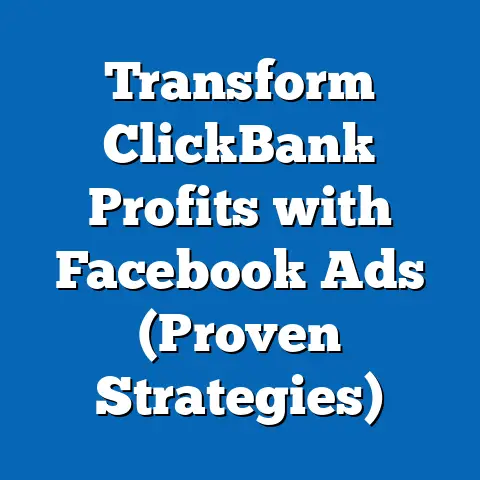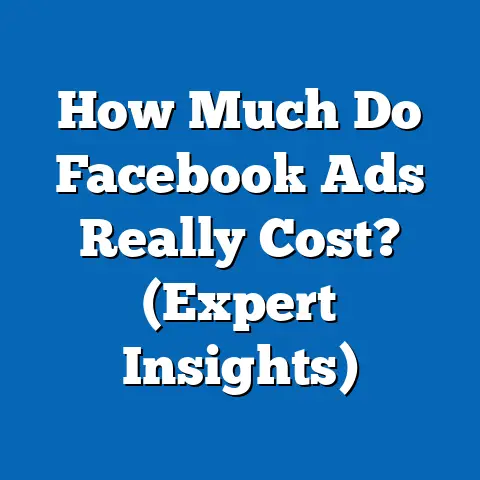Create High-Impact Facebook Ads for Clients (Proven Strategies)
Imagine a world where every scroll on a smartphone screen stops at your client’s ad—a captivating visual, a compelling message, and a call-to-action that feels impossible to ignore. As a digital marketer, you hold the power to transform businesses by creating high-impact Facebook ads that don’t just reach audiences but resonate with them on a personal level. With over 2.9 billion monthly active users as of 2023 (Statista), Facebook remains a dominant platform for advertising, offering unparalleled access to diverse demographics and sophisticated targeting tools.
The stakes are high in this digital arena. According to eMarketer, global digital ad spending is projected to reach $740 billion by 2025, with social media platforms like Facebook accounting for a significant share. Businesses are increasingly relying on skilled marketers to cut through the noise, as the average user is exposed to over 10,000 ads daily across platforms (Forbes). This article dives deep into proven strategies for creating Facebook ads that deliver results, backed by data, trends, and actionable insights tailored for client success.
Demographically, Facebook’s user base spans a wide range, with 69% of U.S. adults using the platform (Pew Research Center, 2023). The largest age group is 25-34 (29.9% of users), followed by 18-24 (23.1%), making it a prime space for targeting both young professionals and Gen Z consumers. Additionally, 54% of users are female, and the platform sees significant engagement from urban and suburban populations. These insights are critical for crafting ads that speak to specific audiences, a cornerstone of effective campaigns.
Section 1: Understanding the Facebook Advertising Landscape
The Evolution of Facebook Ads
Facebook’s advertising journey began in 2007 with the launch of its first ad format, “Flyers,” and has since evolved into a powerhouse with dynamic ad formats like Carousel, Stories, and Lead Ads. By 2022, Facebook’s ad revenue reached $113.6 billion, accounting for nearly 25% of the global digital ad market (Statista). This growth reflects the platform’s ability to adapt to user behavior and technological advancements.
Historically, early ads were simple and text-heavy, but today’s formats prioritize visuals and interactivity. Comparing 2015 to 2023, video ads have surged in popularity, with 62% of marketers reporting higher engagement rates from video content compared to static images (HubSpot, 2023). This shift underscores the need for marketers to stay agile and embrace emerging formats.
Why Facebook Ads Matter for Clients
For businesses, Facebook ads offer a cost-effective way to reach targeted audiences. The average cost-per-click (CPC) on Facebook is $1.72, significantly lower than Google Ads’ $2.69 (WordStream, 2023). Moreover, the platform’s return on ad spend (ROAS) averages 9.21x, meaning for every dollar spent, businesses can expect over $9 in revenue (Hootsuite, 2022).
Small and medium-sized businesses (SMBs), which make up 90% of Facebook’s advertising clients, benefit most from this affordability. With precise targeting options—such as interests, behaviors, and custom audiences—marketers can ensure ads reach the right people at the right time. This precision is why 74% of businesses report using Facebook as their primary social media advertising platform (Social Media Examiner, 2023).
Section 2: Key Strategies for Creating High-Impact Facebook Ads
1. Know Your Client’s Audience Inside Out
The foundation of any successful ad campaign is a deep understanding of the target audience. Facebook’s Audience Insights tool allows marketers to analyze demographics, interests, and behaviors of potential customers. For instance, a 2023 study by Sprout Social found that 66% of consumers feel more connected to brands that personalize content based on their preferences.
Consider demographic differences: younger users (18-24) are more likely to engage with trendy, meme-driven content, while older users (35-54) prefer value-driven messaging, such as discounts or testimonials (Pew Research Center, 2023). Tailoring ad copy and visuals to these nuances can increase click-through rates (CTR) by up to 14% (AdEspresso, 2022).
Actionable Tip: Use A/B testing to experiment with different audience segments. For example, test an ad targeting women aged 25-34 with a focus on lifestyle benefits against one targeting men in the same age group with a focus on product features. Analyze which resonates more using Facebook’s Ad Manager metrics.
2. Leverage Compelling Visuals and Video Content
Visuals are the heartbeat of Facebook ads. According to Facebook’s own data, ads with images or videos generate 65% more engagement than text-only ads. Furthermore, video ads have an average CTR of 1.84%, compared to 0.9% for static images (WordStream, 2023).
Short-form videos, especially those under 15 seconds, perform best for capturing attention in crowded feeds. A 2022 study by Wistia found that 76% of users watch videos on social media with sound off, emphasizing the importance of captions and strong visual storytelling.
Visualization Description: Imagine a bar chart showing engagement rates across ad formats—video ads towering at 1.84% CTR, followed by carousel ads at 1.2%, and static images at 0.9%. This visual would highlight the undeniable impact of dynamic content.
Actionable Tip: For clients in e-commerce, create product demo videos that highlight key features in the first 3 seconds. Use tools like Canva or Adobe Premiere Rush for quick, professional edits.
3. Craft Irresistible Ad Copy
While visuals grab attention, copy converts. The best ad copy is concise, benefit-focused, and includes a clear call-to-action (CTA). Research by AdEspresso shows that ads with CTAs like “Shop Now” or “Learn More” increase conversion rates by 32% compared to ads without explicit instructions.
Consider historical trends: in 2018, emotional storytelling in ad copy boosted engagement by 18%, but by 2023, direct and urgent messaging (e.g., “Limited Time Offer”) outperformed emotional appeals by 25% (HubSpot, 2023). This shift reflects users’ growing preference for quick, actionable content amidst information overload.
Actionable Tip: Write headlines under 40 characters and descriptions under 125 characters to ensure visibility on mobile devices, where 98% of Facebook users access the platform (Statista, 2023). Test urgency-driven phrases like “Don’t Miss Out!” against softer CTAs like “Explore Today.”
4. Optimize for Mobile-First Experiences
With 98.5% of Facebook users accessing the platform via mobile devices, mobile optimization is non-negotiable (DataReportal, 2023). Ads that load slowly or display poorly on smaller screens see a 52% drop in engagement (Google, 2022). Vertical formats, such as 9:16 for Stories or Reels, perform best, with 43% higher completion rates than horizontal formats (Facebook Business, 2023).
Actionable Tip: Use Facebook’s Creative Hub to preview how ads appear on mobile devices. Ensure images are high-resolution (at least 1080×1080 pixels) and text occupies less than 20% of the visual space to avoid delivery issues.
5. Utilize Advanced Targeting and Retargeting
Facebook’s targeting capabilities are a goldmine for marketers. Custom Audiences allow you to target users who have interacted with your client’s website, app, or previous ads, while Lookalike Audiences expand reach to similar users. A 2023 study by Hootsuite found that retargeting ads have a 70% higher conversion rate than ads targeting cold audiences.
Demographic patterns matter here too. For instance, retargeting works particularly well with users aged 25-44, who are 31% more likely to complete a purchase after seeing a follow-up ad (Sprout Social, 2023). Meanwhile, Lookalike Audiences are effective for reaching younger users (18-24) who are exploring new brands.
Actionable Tip: Set up a Facebook Pixel on your client’s website to track user behavior and build Custom Audiences. Create retargeting campaigns for users who abandoned carts, offering a 10-15% discount to incentivize completion.
Section 3: Measuring Success and Iterating for Improvement
Key Metrics to Track
Success in Facebook advertising hinges on data-driven decisions. Key performance indicators (KPIs) like CTR, conversion rate, and ROAS provide insights into campaign effectiveness. For context, the average CTR across industries is 0.9%, but top-performing campaigns often achieve 2-3% (WordStream, 2023). Conversion rates vary by industry—e-commerce averages 2.9%, while fitness sees 5.3% (AdEspresso, 2023).
Visualization Description: Picture a line graph comparing CTR trends from 2020 to 2023, showing a slight decline from 1.1% to 0.9% due to increased competition, but a spike in conversion rates from 2.5% to 3.1% as targeting improves. This would illustrate the evolving landscape of ad performance.
The Power of A/B Testing
A/B testing is a proven methodology for refining ads. By testing variables like headlines, images, or audience segments, marketers can identify what drives results. A 2022 study by Optimizely found that 58% of marketers who regularly A/B test report a 20% or higher increase in conversions.
Actionable Tip: Run A/B tests for at least 7 days to gather statistically significant data, ensuring a minimum budget of $50 per variant. Use Facebook’s split testing feature to isolate variables and avoid overlap.
Section 4: Industry-Specific Strategies and Case Studies
E-Commerce: Driving Sales with Dynamic Ads
For e-commerce clients, Dynamic Product Ads (DPAs) are a game-changer. These ads automatically show products to users based on their browsing history, with a 34% higher ROAS than standard ads (Facebook Business, 2022). A case study by Shopify revealed that a mid-sized retailer saw a 3x increase in sales after implementing DPAs targeting cart abandoners.
Demographic Insight: Women aged 25-34 are 27% more likely to click on product ads than men in the same age group (Sprout Social, 2023). Tailor visuals and messaging to highlight lifestyle benefits for this audience.
Local Businesses: Boosting Foot Traffic
Local businesses can leverage Facebook’s “Store Visits” objective to drive in-person traffic. A 2023 report by Facebook IQ found that 78% of users who saw a local ad visited the store within a week. Geo-targeting within a 1-5 mile radius ensures relevance, especially for urban demographics.
Case Study: A small bakery in Chicago used geo-targeted ads with a “Get Directions” CTA, resulting in a 40% increase in foot traffic over 30 days (Facebook Case Studies, 2023). This highlights the power of hyper-local strategies.
Section 5: Common Pitfalls to Avoid
Overloading Ads with Text
Facebook’s 20% text rule for images isn’t just a guideline—it’s a performance factor. Ads with excessive text see a 30% drop in reach due to algorithm penalties (Facebook Business, 2023). Use tools like Facebook’s Text Overlay Tool to check compliance before launching.
Ignoring Ad Fatigue
Ad fatigue occurs when audiences see the same ad too often, leading to a 17% decrease in CTR after two weeks of unchanged creative (Hootsuite, 2023). Rotate ad creatives every 7-10 days and monitor frequency metrics in Ad Manager.
Neglecting Budget Allocation
Underfunding campaigns limits reach, while overspending on underperforming ads wastes resources. Allocate 60% of the budget to high-performing audiences and 40% to testing new segments, adjusting based on weekly performance data (WordStream, 2023).
Section 6: Future Trends in Facebook Advertising
The Rise of AI and Automation
Artificial Intelligence (AI) is reshaping Facebook ads, with tools like Advantage+ automating audience targeting and creative optimization. By 2025, 80% of marketers are expected to use AI-driven ad tools, according to Gartner. Early adopters report a 22% increase in ROAS using automated bidding strategies (Facebook Business, 2023).
Focus on Privacy and Data Ethics
With Apple’s iOS 14.5 update and increasing privacy regulations, tracking capabilities like the Facebook Pixel face limitations. A 2023 survey by eMarketer found that 64% of marketers are shifting toward first-party data strategies, such as email lists and on-platform engagement, to maintain targeting accuracy.
Integration with Emerging Platforms
Facebook’s integration with Instagram and WhatsApp offers cross-platform opportunities. Ads running simultaneously on Facebook and Instagram see a 19% higher reach, while WhatsApp Business ads are gaining traction for customer service-focused campaigns (Hootsuite, 2023).
Conclusion: Building a Legacy of Impactful Ads
Creating high-impact Facebook ads for clients is both an art and a science. By leveraging data-driven strategies—such as audience targeting, compelling visuals, and continuous optimization—marketers can deliver measurable results that transform businesses. The numbers speak for themselves: with a potential audience of nearly 3 billion users and an average ROAS of 9.21x, Facebook remains an unmatched platform for driving growth.
Looking ahead, the landscape will continue to evolve with AI, privacy changes, and cross-platform integrations. Marketers who adapt to these trends while maintaining a focus on audience connection will not only meet client goals but exceed them, building campaigns that leave a lasting impact. As competition intensifies, the ability to craft ads that stand out will be the defining factor in digital marketing success.
Sources: Statista, eMarketer, Pew Research Center, WordStream, Hootsuite, Social Media Examiner, HubSpot, Sprout Social, AdEspresso, Facebook Business, DataReportal, Google, Wistia, Optimizely, Gartner, Shopify, Facebook IQ, Facebook Case Studies.

